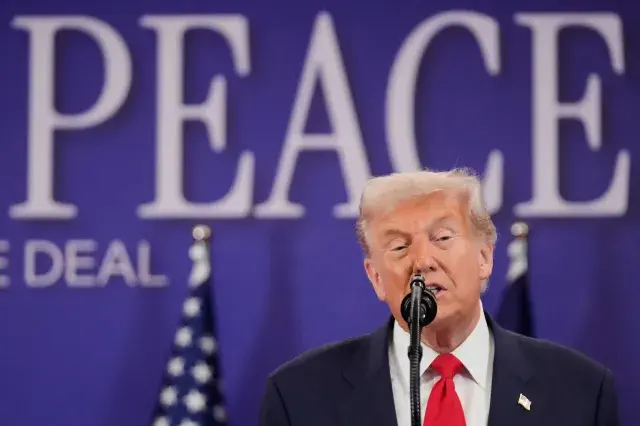Trump Repeats Claim He Ended 8 Wars, Says No President Has Ever Solved One – Newsweek

Report on Conflict Resolution Efforts and Alignment with Sustainable Development Goals
Executive Summary: Assessing Diplomatic Interventions in the Context of SDG 16
This report analyzes claims of successful conflict resolution in eight distinct regions, evaluating these diplomatic efforts against the framework of the United Nations Sustainable Development Goals (SDGs), particularly SDG 16: Peace, Justice and Strong Institutions. While interventions have led to ceasefires and de-escalation in several cases, a comprehensive review indicates that the progress is often fragile and does not fully constitute the establishment of lasting peace as envisioned by the 2030 Agenda for Sustainable Development. The achievement of sustainable peace is a prerequisite for progress across all other SDGs, including poverty reduction (SDG 1), zero hunger (SDG 2), and economic growth (SDG 8).
Analysis of Specific Conflict Interventions and SDG Implications
-
Israel-Hamas Conflict
- A temporary truce and hostage exchange have been facilitated. This action provides a crucial, albeit limited, window for humanitarian access, which is vital for achieving SDG 2 (Zero Hunger) and SDG 3 (Good Health and Well-being) in the affected areas.
- However, the intervention falls short of a comprehensive resolution. The core issues remain unaddressed, indicating that the progress towards SDG 16.1 (significantly reduce all forms of violence) is tenuous and reversible. Lasting peace remains elusive.
-
Israel-Iran Conflict
- U.S. intervention successfully de-escalated a 12-day period of direct military hostilities, a critical step in preventing a wider regional war. This aligns with the immediate goal of SDG 16 to reduce violence.
- The underlying conflict persists, posing a continuous threat to regional stability. This instability undermines the long-term security necessary to build strong institutions and foster partnerships for sustainable development (SDG 17).
-
Egypt-Ethiopia Dispute
- The situation is characterized as an intense diplomatic dispute over water and energy resources, specifically the Grand Ethiopian Renaissance Dam, rather than an armed conflict. This directly involves SDG 6 (Clean Water and Sanitation) and SDG 7 (Affordable and Clean Energy).
- The claim of ending a “war” is unsubstantiated. The ongoing nature of the dispute highlights challenges in regional cooperation and partnership, a key component of SDG 17.
-
India-Pakistan Tensions
- Mediation efforts are credited with helping to de-escalate tensions in Kashmir, preventing a potential escalation into a larger conflict. This intervention supports the aims of SDG 16 by averting violence.
- The core territorial and political disputes remain unresolved. The lack of a durable peace settlement continues to impede cross-border cooperation, economic development (SDG 8), and human security in the region.
-
Serbia-Kosovo Relations
- Diplomatic efforts facilitated an agreement on economic normalization. This directly supports SDG 8 (Decent Work and Economic Growth) and SDG 9 (Industry, Innovation and Infrastructure) by fostering economic ties.
- However, the lack of political reconciliation and persistent tensions demonstrate that economic agreements alone are insufficient to achieve the broader goals of SDG 16, which requires building effective, accountable, and inclusive institutions.
-
Rwanda-Democratic Republic of the Congo (DRC) Tensions
- Despite diplomatic progress between the two states, the fundamental objectives of SDG 16 are severely undermined by continued violence from armed groups in eastern Congo.
- The persistence of conflict prevents the establishment of security and the rule of law, thereby obstructing progress on all other SDGs, including poverty eradication (SDG 1), education (SDG 4), and health (SDG 3).
-
Armenia-Azerbaijan Conflict
- A U.S.-hosted agreement has set the groundwork for a formal peace treaty and the reopening of transport routes. This represents a significant step towards SDG 16.
- The reopening of infrastructure corridors can enhance regional trade and economic growth, contributing to SDG 8 and SDG 9. The pending ratification of the agreement underscores that the peace process is not yet complete.
-
Cambodia-Thailand Border Conflict
- The use of economic leverage, tying future trade deals to peace, successfully prompted a ceasefire. This highlights the interconnectedness of economic policy and peace-building, linking SDG 17 (Partnerships for the Goals) with SDG 16.
- The resolution of the border clashes has restored stability, allowing for a renewed focus on bilateral cooperation and sustainable development.
Conclusion: The Fragility of Peace and the Path to Sustainable Development
The analysis indicates that while diplomatic interventions have been instrumental in brokering ceasefires and de-escalating active hostilities, many of these achievements represent provisional steps rather than comprehensive and sustainable peace. The fragility of these agreements highlights the profound challenges in achieving SDG 16. For peace to be sustainable, efforts must move beyond immediate crisis management to address the root causes of conflict, build resilient and inclusive institutions, and ensure that peace dividends contribute to broader development goals. Without durable peace, progress on the 2030 Agenda will remain at risk in these volatile regions.
Analysis of Sustainable Development Goals in the Article
1. Which SDGs are addressed or connected to the issues highlighted in the article?
The article primarily addresses issues related to the following Sustainable Development Goals (SDGs):
- SDG 16: Peace, Justice and Strong Institutions: The central theme of the article is conflict resolution, peace-making efforts, and ending wars. It discusses ceasefires, truces, and diplomatic negotiations in multiple regions, such as the ceasefire between Thailand and Cambodia, the Israel-Hamas truce, and the de-escalation of hostilities between Israel and Iran. These actions are directly aligned with the goal of promoting peaceful and inclusive societies.
- SDG 17: Partnerships for the Goals: The article highlights the role of international cooperation and diplomacy in resolving conflicts. It details the involvement of the United States, under the Trump administration, in mediating disputes between various nations (e.g., India-Pakistan, Armenia-Azerbaijan). It also mentions Malaysia’s role as a mediator between Cambodia and Thailand. This emphasis on international partnerships to achieve peace connects directly to SDG 17.
2. What specific targets under those SDGs can be identified based on the article’s content?
Based on the article’s content, the following specific targets can be identified:
-
Target 16.1: Significantly reduce all forms of violence and related death rates everywhere. The article explicitly discusses efforts to end active conflicts and prevent further violence. Examples include:
- The ceasefire between Cambodia and Thailand after “border clashes left several soldiers wounded.”
- The Israel-Hamas truce, which “paused fighting.”
- The U.S. intervention that “stopped escalating hostilities” between Israel and Iran.
- The ceasefire reached between India and Pakistan after “tourist killings in Kashmir.”
All these actions are direct attempts to achieve Target 16.1.
- Target 16.A: Strengthen relevant national institutions, including through international cooperation, for building capacity at all levels, in particular in developing countries, to prevent violence and combat terrorism and crime. The article describes international cooperation aimed at preventing and stopping violence. The U.S. administration’s role in “brokering ceasefires and facilitating dialogue” and Malaysia’s mediation efforts are examples of international cooperation strengthening the capacity for conflict resolution.
- Target 17.16: Enhance the global partnership for sustainable development, complemented by multi-stakeholder partnerships that mobilize and share knowledge, expertise, technology and financial resources, to support the achievement of the sustainable development goals in all countries, in particular developing countries. The diplomatic efforts described in the article, where one country (the U.S.) uses its influence and resources to mediate peace between others, is a clear example of a global partnership for sustainable development, specifically for achieving peace (SDG 16). The article notes that progress in the Cambodia-Thailand conflict “came only after Trump tied future U.S. trade deals to peace,” demonstrating the use of financial/economic leverage within this partnership.
3. Are there any indicators mentioned or implied in the article that can be used to measure progress towards the identified targets?
The article implies several indicators that can be used to measure progress, although it does not cite specific quantitative data:
- Implied Indicator for Target 16.1: The article implies the relevance of Indicator 16.1.2 (Conflict-related deaths per 100,000 population). It mentions events that would be measured by this indicator, such as “tourist killings in Kashmir” and “border clashes left several soldiers wounded.” The success of the ceasefires and peace deals discussed would be measured by a reduction or complete cessation of such violent incidents and related casualties.
-
Implied Indicators for Target 16.A and 17.16: The article provides qualitative indicators for progress. These are not official UN indicators but are evident from the text:
- The number and status of peace agreements or ceasefires brokered: The article lists eight conflicts where the administration claims to have ended wars or brokered peace. The signing of a deal between Armenia and Azerbaijan to set “groundwork for a peace treaty” is a concrete, measurable outcome.
- The establishment of diplomatic dialogue: The act of hosting leaders at the White House (Armenia-Azerbaijan) or engaging in mediation (India-Pakistan) serves as an indicator of active international cooperation to prevent violence.
- The fragility of agreements: The article also implies a measure of the durability of peace. It notes that many agreements are “fragile and provisional,” with “ceasefires breaking down” (Rwanda-DRC) or major issues remaining “unresolved” (Israel-Hamas), indicating that progress is not yet stable.
4. SDGs, Targets and Indicators Identified in the Article
| SDGs | Targets | Indicators |
|---|---|---|
| SDG 16: Peace, Justice and Strong Institutions | 16.1: Significantly reduce all forms of violence and related death rates everywhere. | Implied Indicator 16.1.2: Reduction in conflict-related deaths and injuries, as suggested by mentions of “tourist killings,” “soldiers wounded,” and efforts to stop “hot war” and “hostilities.” |
| SDG 16: Peace, Justice and Strong Institutions | 16.A: Strengthen relevant national institutions, including through international cooperation, for building capacity… to prevent violence. | Qualitative Indicators (Implied): The existence of international mediation efforts (U.S., Malaysia), facilitation of dialogue, and brokering of ceasefires as described in the article. |
| SDG 17: Partnerships for the Goals | 17.16: Enhance the global partnership for sustainable development… to support the achievement of the sustainable development goals in all countries. | Qualitative Indicators (Implied): The number of signed peace/ceasefire agreements (e.g., Armenia-Azerbaijan deal), and the use of diplomatic and economic leverage (e.g., tying U.S. trade deals to peace for Cambodia-Thailand) as a function of international partnership. |
Source: newsweek.com
What is Your Reaction?
 Like
0
Like
0
 Dislike
0
Dislike
0
 Love
0
Love
0
 Funny
0
Funny
0
 Angry
0
Angry
0
 Sad
0
Sad
0
 Wow
0
Wow
0


















































.jpg.webp?itok=0ZsAnae9#)





/environment-climate-change-and-health-(ech)/water-sanitation-hygiene-and-health-(wsh)/landfill-tuvalu-36092.tmb-1200v.jpg?sfvrsn=5c21fe40_1#)



















